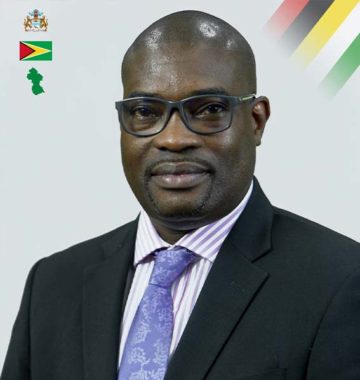Capital: Georgetown
Official Language: English
Status: Independent Republic 26 May 1966
Area: 214,970 sq Km, 83,000 sq Mi
Population: 763,222 (2010)
Currency: Guyanese dollars (GYD)
Motto: One People, One Nation, One Destiny
Land of many waters
Guyana, like many CARICOM countries, continues to depend on imported oil that fuels the electricity and transport sectors. Simultaneously, the high level of expenditure on oil reduces the financial resources available to invest in social development, environmental protection, adaptation to climate change and improving food security. The electricity sector in Guyana, in particular, offers significant opportunities for achieving reductions in fossil imports. However, fiscal and regulatory barriers to energy efficiency and renewable energy use are apparent in Guyana. Guyana possesses an abundance of water resources with a potential installed capacity of over 7,000 MW of hydroelectric power.

Minister of Public Infrastructure
Wight’s Lane, Kingston Georgetown
Tel: (592) 231-8127/8; (592) 231-8115
Fax: (592) 231-8114
Email: minister@publicinfrastructure.gov.gy
minister.infrastructure@gmail.com
Cc : alisa.gomes@yahoo.com (Secretary)
Chief Executive Officer, Guyana Energy Agency
Guyana lies on the northern coastline of South America. It is bordered to the east by Suriname, to the south-west by Brazil, to the north-west by Venezuela and to the north by the Atlantic Ocean. It is the site of the Headquarters of the Caribbean Community (CARICOM).
The original inhabitants were the Amerindians. Guyana was settled by the Dutch in the 16th century and changed hands among the Dutch, British, and French from the late 16th century. It was finally ceded to Britain in 1814. Independence was achieved in 1966; and the Cooperative Republic of Guyana was established in 1970.
Agriculture is the main sector, while the forestry, fishing and mining sectors are important areas of economic activity in Guyana.
Manufacturing, mainly the processing and refining of agricultural products continues to be of importance to Guyana. The country continues to diversify its economy with emphasis being placed on its Information Communication Technology and Services sectors. In addition, the country is also focusing on tourism, energy and light manufacturing.
Cheddi Jagan International, Timehri
Eugene F. Correira International Airport
Commercial: 8:00 a.m. to 4:30 p.m. Monday to Thursday; Saturday 8:00 a.m. to 12 noon
Government: 8:00 am to 4:30 pm. Monday to Friday
New Year’s Day, January 1; Eid-ul-Azah (as decreed);
Republic Day, February 23; Phagwah (as decreed); Youman Nabi (as decreed) Good Friday; Easter Monday; Labour Day, May 1; Arrival Day, May 5; Independence Day, May 26; CARICOM Day, July 4; Emancipation Day, August 1; Diwali (as decreed); Christmas Day December 25; Boxing Day December 26. Holidays that fall on a Sunday are observed the following Monday.
1 August, 1973
Red – People’s deal in nation-building
Black – Endurance and perseverance
Gold – Mineral resources
White – Rivers
Green – Land